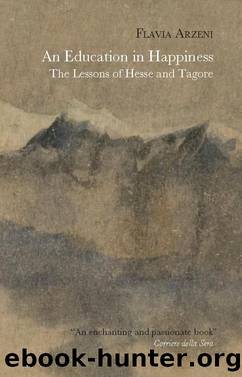An Education in Happiness: The Lessons of Hesse and Tagore by Flavia Arzeni

Author:Flavia Arzeni [Arzeni, Flavia]
Language: eng
Format: epub
Tags: Autobiography, Biography, Literary Criticism, Literary Figures
ISBN: 9781908968944
Google: -ROFAAAAQBAJ
Amazon: B00LGUEUPY
Publisher: Pushkin Press
Published: 2012-08-30T23:00:00+00:00
THE ART OF LOOKING
HESSE, IN FACT, does not deny that on the way to love and joy, along with little things, there are also greater things—among them, art. The enjoyment of works of art is today within everyone’s reach—it is not necessary to belong to an elite. Visits to museums and major exhibitions are one of the most common hobbies and we often see long queues in front of the ticket office for a good exhibition that has been heavily publicised in the media or for a concert by a famous conductor. Such things are considered moments of cultural enrichment, pleasure or escape. Hesse did not like fashionable cultural events and might have been surprised to see the function which art has taken on in the consumer society. Personally, apart from literature, he was much drawn to painting and music.
He tried to find in painting and music what he also found in nature, in books and in Eastern cultures—a point of support, a refuge, an aid to living. His concept of art was classical and humanist. He had a preference for a serene, Apollonian art that resolves conflicts, rather than a Dionysian art of intoxication or turmoil.
He loved words. There is no doubt that literature was the great love of his life, because in words, above all in his poetic works, he found “clarity, comfort, justification and new joy, new innocence and new love of life.”49 Consistent with his own principles, he also loved other people’s words as much as his own. But painting, too, had a special place among Hesse’s loves. In his youth his Italian excursions were an immersion in painting. He spent whole days at the Uffizi, visited churches, studied altarpieces, and in the pages of his diary he made insightful comments on the works of the old masters, from Botticelli to Perugino.
In Venice, he enthused over Titian, Bellini, Giorgione and Veronese. Looking at old master paintings, or admiring a splendid cathedral or a nobleman’s palace, he found comfort in the thought that the efforts of so many men over the centuries had not been in vain; that something important and universally valid connected them and that this gave confidence and hope to everyone. In art, as in religion, he was searching for the echo of a long-ago primal wisdom: “Every true poet has a spark of this wisdom; without it, art and religion are not possible.”50 This, for Hesse, is the huge attraction that art, whether literature, painting or music, has for man—it unites what is divided, combines the real and the spiritual, the subject and the object, and in this unity the breath of the divine can be felt.
Download
This site does not store any files on its server. We only index and link to content provided by other sites. Please contact the content providers to delete copyright contents if any and email us, we'll remove relevant links or contents immediately.
| Ancient & Classical | Arthurian Romance |
| Beat Generation | Feminist |
| Gothic & Romantic | LGBT |
| Medieval | Modern |
| Modernism | Postmodernism |
| Renaissance | Shakespeare |
| Surrealism | Victorian |
4 3 2 1: A Novel by Paul Auster(11044)
The handmaid's tale by Margaret Atwood(6850)
Giovanni's Room by James Baldwin(5876)
Big Magic: Creative Living Beyond Fear by Elizabeth Gilbert(4721)
Asking the Right Questions: A Guide to Critical Thinking by M. Neil Browne & Stuart M. Keeley(4572)
On Writing A Memoir of the Craft by Stephen King(4212)
Ego Is the Enemy by Ryan Holiday(3989)
Ken Follett - World without end by Ken Follett(3972)
The Body: A Guide for Occupants by Bill Bryson(3797)
Bluets by Maggie Nelson(3707)
Adulting by Kelly Williams Brown(3667)
Guilty Pleasures by Laurell K Hamilton(3585)
Eat That Frog! by Brian Tracy(3512)
White Noise - A Novel by Don DeLillo(3433)
The Poetry of Pablo Neruda by Pablo Neruda(3364)
Alive: The Story of the Andes Survivors by Piers Paul Read(3309)
The Bookshop by Penelope Fitzgerald(3225)
The Book of Joy by Dalai Lama(3215)
Fingerprints of the Gods by Graham Hancock(3210)
